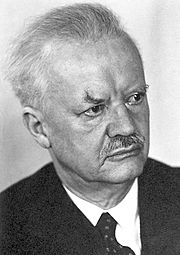Hans Spemann facts for kids
Quick facts for kids
Hans Spemann
|
|
|---|---|
 |
|
| Born | 27 June 1869 |
| Died | 9 September 1941 (aged 72) |
| Nationality | German |
| Known for | Embryonic induction and the Organiser |
| Awards | Nobel Prize in Physiology or Medicine (1935) |
| Scientific career | |
| Fields | Embryology |
| Doctoral advisor | Theodor Boveri |
Hans Spemann (27 June 1869 – 9 September 1941) was a German scientist who studied how living things develop. He was an embryologist, which means he focused on embryos (very early stages of life). In 1935, he won the Nobel Prize in Physiology or Medicine. This award was for a discovery made by his student, Hilde Mangold. She found out about something called embryonic induction. This is a process where one part of an embryo tells other cells what to become, guiding them to form specific tissues and organs.
Contents
Hans Spemann's Early Life and Education
Hans Spemann was born in Stuttgart, Germany, on June 27, 1869. He was the oldest son of Wilhelm Spemann, who was a publisher. After finishing school in 1888, Hans worked for a year in his father's business. He then served in the military and worked briefly as a bookseller.
In 1891, he started studying medicine at the University of Heidelberg. There, he met a biologist named Gustav Wolff. Wolff was doing experiments on how newts develop. He showed that if a newt's eye lens was removed, it could grow back.
In 1892, Spemann married Klara Binder. They had four children together. From 1893 to 1894, he continued his medical training at the University of Munich. However, he decided he wanted to be a scientist, not a doctor. He then moved to the Zoological Institute at the University of Würzburg. In 1895, he earned his degree in zoology, botany, and physics. He studied under famous scientists like Theodor Boveri and Wilhelm Röntgen, who discovered X-rays.
For his Ph.D., Spemann studied tiny worms. He believed that to understand biology, you needed to look at the whole organism, not just its tiny parts.
How Embryos Develop: Early Experiments
In 1896, while recovering from an illness, Spemann read a book about how traits are passed down and how living things develop. This book inspired him to do his own experiments.
At that time, scientists were trying to understand how a single cell develops into a complete animal. Some experiments had confusing results. For example, in 1888, Wilhelm Roux tried an experiment on frog embryos. He killed one of the first two cells of a developing embryo. He found that the remaining cell grew into only half an embryo.
However, in 1892, Hans Driesch did a similar experiment with sea urchin embryos. Instead of killing one cell, he separated the two cells completely. He found that each cell could grow into a complete, but smaller, embryo. This showed that early cells in an embryo could still form a whole organism, not just a part. This was a big deal because it helped scientists understand that embryos are more flexible than they first thought.
Spemann became very skilled at using tiny tools for surgery on embryos. He used a loop made from a baby's hair to carefully divide embryo cells. He found that one half of an embryo could indeed form a whole embryo, but only if the cut was made in the right way. This helped scientists understand how cells work together to form a complete animal.
Discovery of Organizers and Induction
In 1908, Spemann became a professor in Rostock. Later, in 1914, he moved to the Kaiser Wilhelm Institute of Biology in Berlin. Here, he did the experiments that made him famous. He worked with a student named Hilde Mangold.
Their experiments, published in 1924, involved taking a small group of cells from one embryo and moving them to another embryo. They found that this small group of cells could "organize" or "tell" the new embryo's cells to form new body parts, like a second head or a second spinal cord. Spemann called these special areas "organiser centres" or "organisers." He later showed that different parts of these organisers could create different parts of the embryo.
Even after his discovery, Spemann wondered if there was a special "life force" guiding development. However, other scientists later showed that the organisers worked because of certain chemical signals, not a mysterious force.
From 1919, Spemann was a professor at the University of Freiburg-im-Breisgau. In 1928, he was the first to successfully transfer the nucleus (the control center of a cell) from one amphibian embryo cell to another. This was an early step towards what we now call cloning. He received the Nobel Prize in 1935 for his important work. He wrote a book about his ideas called Embryonic Development and Induction (1938).
Hans Spemann passed away on September 9, 1941. He loved classic books and often held gatherings with friends to talk about art, literature, and philosophy.
Hans Spemann and Politics
Hans Spemann lived during a difficult time in Germany. In 1935, when he accepted his Nobel Prize, he gave a Nazi salute. This was a common gesture in Germany at that time, showing support for the ruling political party.
See also
 In Spanish: Hans Spemann para niños
In Spanish: Hans Spemann para niños

